Quantifying Rather Than Counting
Encourage children to quantify objects logically and to compare sets (rather than encouraging him to count).
When encouraging children to quantify rather than count, Kamii describes a typical interaction that takes place every day in every child care center around the country. The teacher asks a child to place cups on the table for snack time. She asks, “Will you bring 8 cups?” Kamii says it is better to say, “Will you bring just enough cups for everybody?” so that they child herself, can determine how to best accomplish the request. Rather than telling her exactly “how many” cups are needed, the teacher can provide a more substantial opportunity for the quantification of objects by encouraging the child to figure how many are needed, and then to bring just enough so that everyone has one.
Each child will approach this dilemma with their own ideas about how to solve it. For instance, some children will bring far more cups than they need so they are sure to have enough. This group will learn that they then have “leftovers” and those must be returned to the cabinet. Other children may make trips, one by one, back and forth to the cabinet, only carrying one cup at a time. This, they will find, is not very efficient, especially if there are many children in the group. Both attempts have their problems which create additional opportunities for the children to quantify, compare, and estimate. Compare that with the first example when the teacher tell the child how many are needed. This allows the child to count out the correct number of cups, but nothing else is explored.
Watch how this child tries to count out the correct number of cups for snack time. He counts them one-by-one but then puts them underneath the pile so there is no beginning or end to the set. He finally just takes some and begins to set the table.
Kamii goes on to explain that counting is important and is of of the foundational skills required for addition and subtraction.
Take a look at a short video that describes how we understand number sense and why children need to develop strong early skills so they stay strong in math later on.
